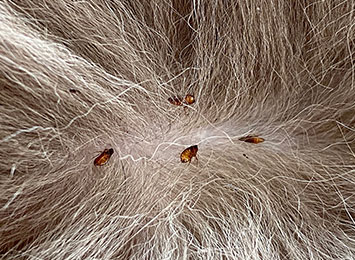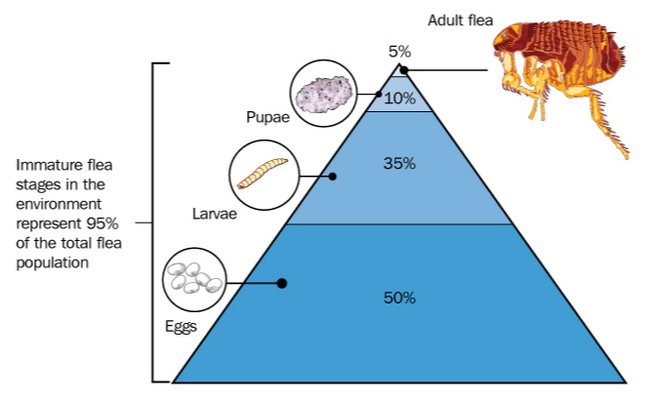Size: Very small; 1/12 to 1/4 inches (2.12 to 6.35 millimeters)
Color: Can include dark brown, black, brown-black, gray, or dark red-brown. Often semi-translucent

Size: Very small; 1/12 to 1/4 inches (2.12 to 6.35 millimeters)
Color: Can include dark brown, black, brown-black, gray, or dark red-brown. Often semi-translucent

Flea bite scabs are small, black- or rust-colored spots that may be inflamed or puffy. They resemble mosquito bites, but they’re usually slightly darker. Fleas usually bite around the shins, neck, or ears. Flea bites don’t usually swell, but they may itch or turn red. Look for patterns of 2 to 3 bite marks in close proximity.
Look for flea eggs in any animal housing or bedding. Flea eggs look like tiny, grainy or sandy grey or black buildup. They may resemble dust or salt and pepper.
Scientific Order: Siphonaptera
Common family: Pulicidae
Common Species:
Cat flea (Ctenocephalides felis)
Dog flea (Ctenocephalides canis)
Human flea (Pulex irritans)
Oriental rat flea (Xenopsylla cheopis)

Vacuum thoroughly and frequently. Consider having your carpets shampooed and/or steam cleaned to remove any larvae or eggs that may be hiding in them. Dust surfaces frequently, especially in dark areas of the home that aren’t often accessed, such as a basement or cellar.
Practice humidity control and consider investing in a dehumidifier for vulnerable areas. Mop hard floors frequently, and make sure to dry them thoroughly when you’re finished. Do not allow lawn debris or garbage to accumulate in piles near your building.
Bathe pets in a flea shampoo and apply a preventative to their skin. Wash all pet bedding and toys.
Fleas are parasitic insects that feed on mammals, including humans and pets. Most species of flea prefer to feed on a specific type of host. Fleas derive their common names from their preferred hosts. All common flea species can feed on humans.
Unlike ticks or most other pest parasites, fleas do not stay latched onto their prey, and may jump on and off a host repeatedly. They attack hosts by leaping directly onto the host and then climbing to a bite-vulnerable area of the body.
Female fleas require blood meals to lay their eggs and can consume up to 15 times their body weight in blood every day. Fleas lay eggs after every blood meal. Some species lay only 4 to 8 eggs, while other species may lay up to 25. Most fleas lay several hundred eggs in their lifetimes.

Mature female fleas usually lay eggs directly on a host they are actively feeding on. These eggs aren’t attached to the host, however, and generally fall off and continue to incubate on the ground or in the host’s home. If a pet has fleas, for instance, it’s probable that there are flea eggs in its bedding.
A flea’s life cycle is broken into four distinct developmental stages: egg, larva, pupa, and adult. Life cycle development depends on temperature and food availability and could take anywhere between a month to 200 days or more. Adult fleas may live for a year or longer.
Fleas are usually a problem in summer but if they get inside, they can continue their reproductive cycle all year. Once an infestation begins, winter won’t stop it.
For flea pest control near me in New York, New Jersey and Connecticut, Call Assured Environments. We can treat your home or business to make sure that any fleas that got in won’t stick around. Trust the experts to make sure eggs and larvae left behind don’t become your next infestation.
New York City Department of Health and Mental Hygiene’s Flea page
Cornell University Department of Entomology’s Flea Insect Diagnostic Laboratory fact sheet
Penn State College of Agricultural Sciences Department of Entomology’s Cat Fleas Insect Advice Extension page
In the natural world, fleas prefer warm, humid and shady areas. They can be found in tall grass, bushes, and under wood piles or leaves and brush. Direct sunlight can kill them.
Fleas have a definite range of temperatures they can survive in. In winter they cannot survive below 46 degrees unless they are attached to a warm host. Eggs and larvae are more sensitive and cannot survive in temperature below 55. In summer, fleas die in heat above 95 degrees. In hotter climates, they may escape the heat via your air-conditioned home.
It is difficult to tell, both insects leave tiny, irritated bites that itch. The best way to identify your bite is determine which pest you’ve been exposed to. Gnats have wings and can fly while fleas lack wings and are limited to jumping and climbing. Flea bites will more likely be on your ankles and legs and in groups of three or more.
Mosquito bites tend to be slightly larger and leave a more pronounced red bump. Flea bites often occur in groupings and may not itch as much. Fleas are wingless and will likely bite around legs and ankles while mosquitoes are attracted to any exposed skin
Mix equal parts baking soda and salt to create a dehydrating agent that will kills fleas, flea eggs and larvae. The mixture removes moisture from the insects until they die. Sprinkle around your home, let sit overnight and then vacuum in the morning.
Yep! Mix it with baking soda (see above).
If you’ve had fleas, there’s a good chance you have eggs or larvae in your carpet. Simply keeping your home clean and your carpets vacuumed will reduce the amount. To be sure you get all the fleas try the baking soda mix outlined above or any number of commercial products. You can also rent a steam cleaner to kill them. When in doubt, call a pest control expert to remedy the situation.
A study at Ohio State University found that vacuuming kills 96% of adult fleas and 100% of younger fleas. To be sure, use a steam cleaner on carpets and furniture.
Yes. Wash all clothes and bedding including that used by pets.
Fleas frequently enter buildings while hitchhiking on other pests. In New York, most fleas initially enter structures while feeding on a rat that carries them inside.
Wash all bedding, toys and supplies. Bathe your pet in a flea shampoo and then apply a preventative.